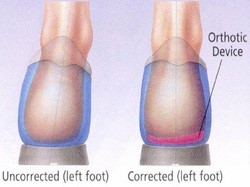|
Foot Function
The feet provide a means of locomotion, as well as function as a shock absorber for the body.
The arch of the foot can absorb the repetitive jolt of walking and protecting larger joints in the legs, hip as well as the back from wearing out and injury.
Working on your feet for long hours can cause tired, achy feet. The feet can benefit from an arch support to reduce the stress which the foot must absorb in a day.
The foot structure and structural variations - a flattened out foot (pes planus) or a high arch position (pes cavus) can harshly affect the foot's ability to perform. The result can strain the ligaments in the foot e.g. plantar faciitis, lead to mechanical deformities such as bunions, hammer toes, pinched nerves (neuroma) or result in aches and pains in the knees or back.
Orthotics refers to any device placed into a shoe, ranging from felt pads to custom-made shoe inserts that correct an irregular or abnormal walking pattern.
Sometimes referred to as arch supports, orthotics allow people to stand, walk, and run more efficiently and comfortably.
Over-the-counter orthotic cannot normally correct the wide range of symptoms that prescription foot orthoses can because they are not custom made to fit an individual's unique foot structure.


|

Functional Orthotics
Dependent on an individual’s activity level, a more rigid arch support capable of supporting body weight and accommodating the structural imbalance is necessary.
In order to assurance comfort and function, rigid orthotics must be custom made to the individual, commonly by way of a plaster cast taken of the foot in what is called "neutral position." These rigid devices allow for pronation or flattening out of the foot, required to absorb the shock of walking, yet prevent abnormal extremes of motion associated with foot weakness and over use injury.
Rigid Orthotics
Rigid orthotic devices are intended to control function and are worn mainly for walking or dress shoes.
They are often composed of a firm material, such as plastic or carbon fibre. Rigid orthotics are made from a mould after a podiatrist takes a plaster cast or other kind of image of the foot.
Rigid orthotics control motion in the two major foot joints that lie directly below the ankle joint and may improve or get rid of strains, aches, and pains in the legs, thighs, and lower back.
Semi-Rigid Orthotics
Semi-rigid orthotics provide foot balance for walking or participating in sports. The typical semi-rigid orthotic is made up of layers of soft material, reinforced with more rigid materials.
These orthotics are also used to help athletes ease pain while training and competing.
Soft Orthotics
Soft orthotics are generally used to absorb shock, increase balance, and take pressure off uncomfortable or sore spots. They are usually effective for diabetic, arthritic, and deformed feet.
Soft orthotics are characteristically made up of soft, cushioned materials so that they can be worn against the sole of the foot.
Like rigid orthotics, soft orthotics are also made from a mould after a podiatrist takes a plaster cast or other kind of image of the foot.
|


